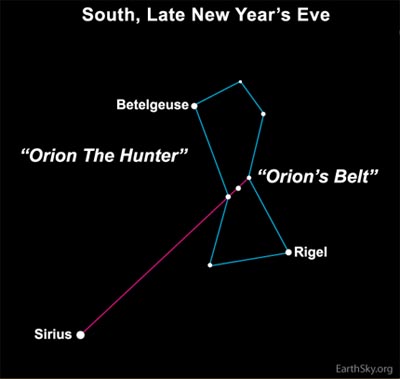Courtesy of EarthSky
A Clear Voice for Science
Visit EarthSky at
www.EarthSky.org [1]
 [2]
[2] [3]Sirius [4] in the constellation Canis Major – the legendary Dog Star – should be called the New Year’s star. This star – the brightest star in our sky – celebrates 2011 and every new year by reaching its highest point in the sky around the stroke of midnight.
[3]Sirius [4] in the constellation Canis Major – the legendary Dog Star – should be called the New Year’s star. This star – the brightest star in our sky – celebrates 2011 and every new year by reaching its highest point in the sky around the stroke of midnight.
How can you find Sirius? It is easy because this star is the brightest one we see from Earth. Its name means ‘Sparkling’ or ‘Scorching.’ In late 2010 and early 2011, only the planet Jupiter outshines Sirius in the evening sky. You won’t confuse them. Jupiter will shine in the south to southwest as Sirius is ascending in the southeast in mid-evening.
If you are not sure, look for the prominent ‘Belt’ stars of the constellation Orion, as shown on today’s chart. Orion’s Belt always points to Sirius.
Sirius is highest in the sky at midnight every New Year’s. Astronomers call this a ‘midnight culmination’ of Sirius. Midnight culmination for Sirius comes tomorrow night, but tonight it is nearly the same. As the New Year rings in, Sirius is at its highest.
By midnight, we mean the middle of the night – midway between sunset and sunrise. Like the sun, the stars rise in the east and travel westward across the sky. When the sun or any star is in the eastern half of the sky, it is climbing upward. When the sun or any star is in the western sky, it is descending downward. Midway between rising and setting, the sun or any star reaches its highest point in the sky.
Sirius will reach its highest point in the sky at midnight New Year’s Day, at the birth of the New Year. Because the stars rise and set 2 hours earlier with each passing month, by February 1 Sirius will reach its highest point for the night around 10 p.m. local time.
Look for Sirius – at midnight culmination tomorrow – highest in the sky around midnight every New Year’s Eve!
Written by Bruce McClure [5]
Astronomy Picture of the Day from NASA/JPL [6]
U.S. Naval Observator Astronomical Information cente [8]r
Universe Today [9]
StarDate Online [10]
Sky and Telescope [11]
National Geographic [12]
Space Com [13]
Simostronomy Blog [14]
Amazing Space [15]
The York County Astronomical Society [16]
Scope City [17]